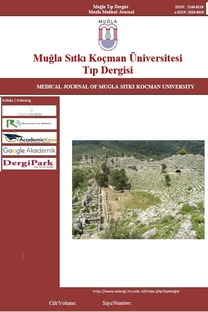Kolorektal Karsinomlardaki Histopatolojik Özellikler
Histopatoloji, Kolorektal Kanser, Prognoz
The Histopathological Features of Colorectal Carcinomas
Colorectal Carcinoma, Histopathology, Prognosis,
___
- 1. WHO Globocan database. http://globocan.iarc.fr/Pages/Map.aspx
- 2. Ahnen DJ, Wade SW, Jones WF ve ark. The increasing incidence of young-onset colorectal cancer: a call to action. Mayo Clin Proc. 2014;89(2):216-24.
- 3. AJCC (American Joint Committee on Cancer) Cancer Staging Manual, 7th edition, Edge, SB, Byrd, DR, Compton, CC, ve ark. (Eds) (Eds), Springer, New York 2010. p.143.
- 4. Jessup JM, Goldberg RM, Asare EA, ve ark. Colon and Rectum. In: AJCC Cancer Staging Manual, 8th, Amin MB (Ed), AJCC, Chicago 2017. p.251.
- 5. Blenkinsopp WK, Stewart-Brown S, Blesovsky L ve ark. Histopathology reporting in large bowel cancer. J Clin Pathol. 1981;34(5):509-13.
- 6. Siegel RL, Miller KD, Jemal A. Cancer statistics, 2016. CA Cancer J Clin. 2016;66(1):7-30.
- 7. Hamilton SR, Bosman FT, Boffetta P, Ilyas M, Morreau H, Nakamura SI et al. Carcinoma of the colon and rectum in WHO classification of tumours of the digestive system 4th ed, 2010 pp:134-46.
- 8. Karim S, Brennan K, Nanji S ve ark. Association Between Prognosis and Tumor Laterality in Early-Stage Colon Cancer. JAMA Oncol. 2017;3(10):1386-92.
- 9. Petrelli F, Tomasello G, Borgonovo K ve ark. Prognostic Survival Associated With Left-Sided vs Right-Sided Colon Cancer: A Systematic Review and Meta-analysis. JAMA Oncol. 2017;3(2):211-219.
- 10. Newland RC, Dent OF, Lyttle MN ve ark. Pathologic determinants of survival associated with colorectal cancer with lymph node metastases. A multivariate analysis of 579 patients. Cancer. 1994;73(8):2076-82.
- 11. Scott NA, Wieand HS, Moertel CG ve ark. Colorectal cancer. Dukes' stage, tumor site, preoperative plasma CEA level, and patient prognosis related to tumor DNA ploidy pattern. Arch Surg. 1987;122(12):1375-9.
- 12. Goldstein NS, Hart J. Histologic features associated with lymph node metastasis in stage T1 and superficial T2 rectal adenocarcinomas in abdominoperineal resection specimens. Identifying a subset of patients for whom treatment with adjuvant therapy or completion abdominoperineal resection should be considered after local excision. Am J Clin Pathol. 1999;111(1):51-8.
- 13. Quah HM, Chou JF, Gonen M ve ark. Identification of patients with high-risk stage II colon cancer for adjuvant therapy. Dis Colon Rectum. 2008;51(5):503-7.
- 14. Compton CC, Fielding LP, Burgart LJ ve ark. Prognostic factors in colorectal cancer. College of American Pathologists Consensus Statement 1999. Arch Pathol Lab Med. 2000;124(7):979-94.
- 15. Hase K, Shatney C, Johnson D ve ark. Prognostic value of tumor "budding" in patients with colorectal cancer. Dis Colon Rectum. 1993;36(7):627-35.
- 16. Nagtegaal ID, Quirke P. What is the role for the circumferential margin in the modern treatment of rectal cancer? J Clin Oncol 2008;26(2):303-12.
- ISSN: 2148-8118
- Yayın Aralığı: 3
- Başlangıç: 2014
- Yayıncı: Muğla Sıtkı Koçman Üniversitesi
Warfarin Nedenli Vertebra Kırığı: Olgu Sunumu
Meltem Hale ALPSAN GOKMEN, Selcuk GOCMEN
Tek Merkezde Kırk Yaş Altı Kadınlarda Meme Biyopsi Sonuçları
Sekiz Haftalık Missed Gebeliği Olan Hastada Uterus Didelfis Varlığı: Bir Olgu Sunumu
Buğra ŞAHİN, Gizem CURA, Fatih ÇELİK, Banuhan ŞAHİN
Gliomatozis Serebri Görüntüleme Bulguları: Olgu Sunumu
Efdal AKKAYA, Gülin MORKAVUK, Alev LEVENTOĞLU, Mehmet YÖRÜBULUT
Serkan DEMİR, Mustafa KARAOGLAN
Kolorektal Karsinomlardaki Histopatolojik Özellikler
Yelda DERE, Özcan DERE, Sümeyye EKMEKÇİ, Serkan Yaşar ÇELİK, Özgür İLHAN ÇELİK, Okay NAZLI
